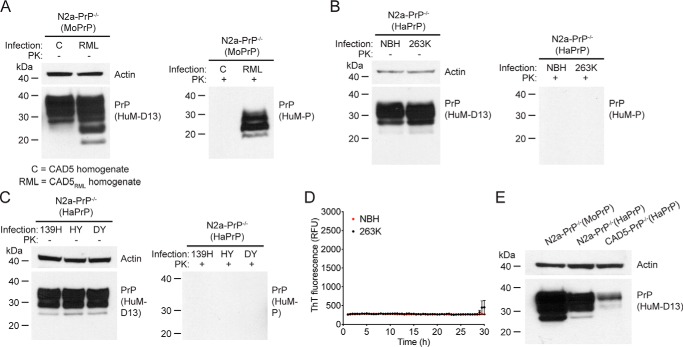Figure 7.
Challenge of transfected N2a-PrP−/− cells with prions. A, challenge of N2a-PrP−/−(MoPrP) cells with mouse RML prions. Immunoblots of either undigested (left blot) or PK-digested (right blot) lysates from cells at passage seven following exposure to homogenates from either uninfected CAD5 cells (C) or RML prion-infected CAD5 cells (RML). B, challenge of N2a-PrP−/−(HaPrP) cells with hamster 263K prions. Immunoblots of either undigested (left blot) or PK-digested (right blot) lysates from cells at passage seven following exposure to NBH or 263K-infected brain homogenate. C, challenge of N2a-PrP−/−(HaPrP) cells with hamster 139H, HY, and DY prion strains. Immunoblots of either undigested (left blot) or PK-digested (right blot) lysates from cells at passage seven following exposure to 139H-, HY-, or DY-infected brain homogenate. D, RT-QuIC using recombinant HaPrP(23–231) as a substrate and lysates (10−3 dilution, passage seven post infection) from N2a-PrP−/−(HaPrP) cells exposed to either 263K homogenate (black) or NBH (red) as a seed. Each data point represents the mean ± S.E. of quadruplicate reactions. E, PrPC levels in lysates from uninfected N2a-PrP−/−(MoPrP), N2a-PrP−/−(HaPrP), and CAD5-PrP−/−(HaPrP) cells, as detected by immunoblotting. A–C and E, PK-resistant PrP was visualized using the antibody HuM-P, and total (undigested) PrP was detected using the antibody HuM-D13. The undigested blots were also reprobed with an antibody to actin (20–33). Molecular mass measurements are indicated in kDa.

